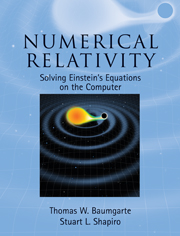Book contents
- Frontmatter
- Contents
- Preface
- Suggestions for using this book
- 1 General relativity preliminaries
- 2 The 3 + 1 decompostion of Einstein's equations
- 3 Constructing initial data
- 4 Choosing coordinates: the lapse and shift
- 5 Matter sources
- 6 Numerical methods
- 7 Locating black hole horizons
- 8 Spherically symmetric spacetimes
- 9 Gravitational waves
- 10 Collapse of collisionless clusters in axisymmetry
- 11 Recasting the evolution equations
- 12 Binary black hole initial data
- 13 Binary black hole evolution
- 14 Rotating stars
- 15 Binary neutron star initial data
- 16 Binary neutron star evolution
- 17 Binary black hole–neutron stars: initial data and evolution
- 18 Epilogue
- A Lie derivatives, Killing vectors, and tensor densities
- B Solving the vector Laplacian
- C The surface element on the apparent horizon
- D Scalar, vector and tensor spherical harmonics
- E Post-Newtonian results
- F Collisionless matter evolution in axisymmetry: basic equations
- G Rotating equilibria: gravitational field equations
- H Moving puncture representions of Schwarzschild: analytical results
- I Binary black hole puncture simulations as test problems
- References
- Index
7 - Locating black hole horizons
Published online by Cambridge University Press: 05 March 2013
- Frontmatter
- Contents
- Preface
- Suggestions for using this book
- 1 General relativity preliminaries
- 2 The 3 + 1 decompostion of Einstein's equations
- 3 Constructing initial data
- 4 Choosing coordinates: the lapse and shift
- 5 Matter sources
- 6 Numerical methods
- 7 Locating black hole horizons
- 8 Spherically symmetric spacetimes
- 9 Gravitational waves
- 10 Collapse of collisionless clusters in axisymmetry
- 11 Recasting the evolution equations
- 12 Binary black hole initial data
- 13 Binary black hole evolution
- 14 Rotating stars
- 15 Binary neutron star initial data
- 16 Binary neutron star evolution
- 17 Binary black hole–neutron stars: initial data and evolution
- 18 Epilogue
- A Lie derivatives, Killing vectors, and tensor densities
- B Solving the vector Laplacian
- C The surface element on the apparent horizon
- D Scalar, vector and tensor spherical harmonics
- E Post-Newtonian results
- F Collisionless matter evolution in axisymmetry: basic equations
- G Rotating equilibria: gravitational field equations
- H Moving puncture representions of Schwarzschild: analytical results
- I Binary black hole puncture simulations as test problems
- References
- Index
Summary
Black holes are characterized by the horizons surrounding them. Clearly, then, the numerical simulation of black holes requires the ability to locate and analyze black hole horizons in numerically generated spacetimes. In this chapter we first review different concepts of horizons in asymptotically flat spacetimes, and then discuss how these horizons can be probed numerically.
Concepts
Several different notions of horizons exist in general relativity. The defining property of a black hole is the presence of an event horizon (Section 7.2), but, as we will see, apparent horizons (Section 7.3) also play an extremely important role in the context of numerical relativity. In addition, the concepts of isolated and dynamical horizons (Section 7.4) serve as useful diagnostics in numerical spacetimes containing black holes.
A black hole is defined as a region of spacetime from which no null geodesic can escape to infinity. The surface of a black hole, the event horizon, acts as a one-way membrane through which light and matter can enter the black hole, but once inside, can never escape. It is the boundary in spacetime separating those events that can emit light rays that can propagate to infinity and those which cannot. More precisely, the event horizon is defined as the boundary of the causal past of future null infinity. It is a 2 + 1 dimensional hypersurface in spacetime formed by those outward-going, future-directed null geodesics that neither escape to infinity nor fall toward the center of the black hole.
- Type
- Chapter
- Information
- Numerical RelativitySolving Einstein's Equations on the Computer, pp. 229 - 252Publisher: Cambridge University PressPrint publication year: 2010



